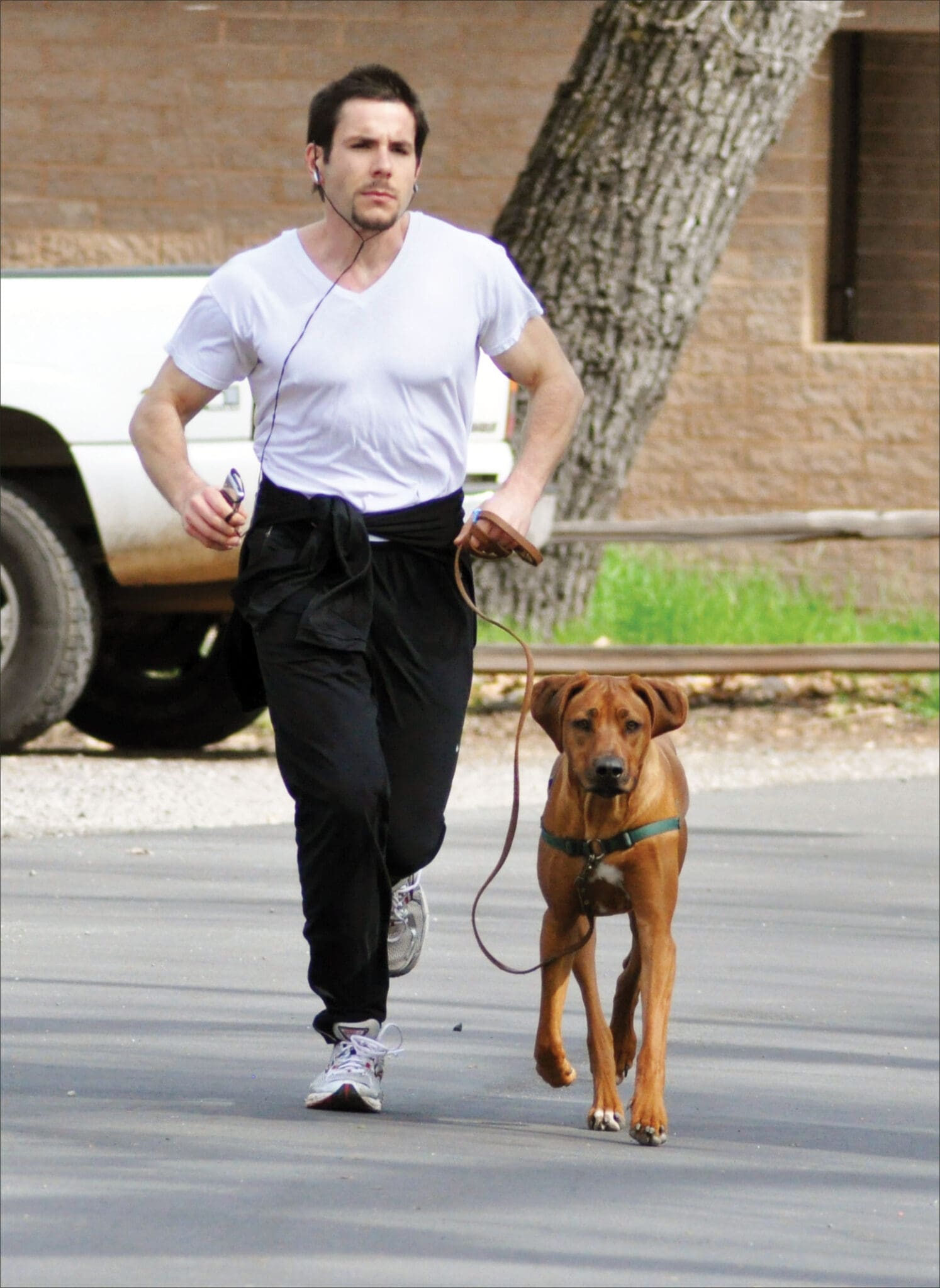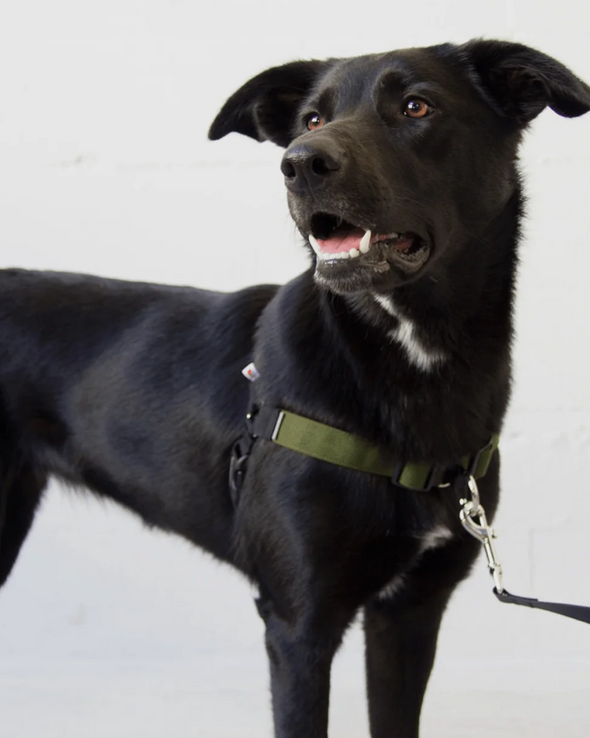Contents
Types of Harnesses
So you’ve got a pooch and now you’re in the market for a harness? Good news! There are heaps of styles to choose from, each with its own perks to fit just about any dog’s personality, quirks, or naughty habits. We’re going to break down the two headliners: the front-clip and back-clip harnesses.
Front-Clip Harnesses
First up, front-clip harnesses—these are your go-to if your pup’s idea of a walk is more chaotic than a coffee-fueled squirrel. They’re also called no-pull harnesses because they wisely attach the leash to your dog’s chest. This setup gives you steering control, which is great when Fido gets the urge to suddenly check out every squirrel, leaf, and intriguing sniff. According to the wizards at Canada Pooch, front-clip harnesses lead the pack in safety and training effectiveness.
| What’s What | The 411 |
|---|---|
| Leash Attachment | Front (chest) |
| Control | High – better navigation over your furry explorer |
| Safety | Cuts down on neck strain (PetHelpful) |
| Best For | Training and keeping pullers in check (Rover.com) |
Here’s a rundown of why front-clips are legit:

- You get to be the boss of the walk.
- Fido’s neck stays comfy with zero strain (PetHelpful).
- Makes it a walk in the park to keep your pupper by your side (Wonder Dog University).
Need tips on becoming a front-clip pro? Check out our handy-dandy guide on using front-clip harnesses.
Benefits of Front-Clip Harnesses
Thinking about switching up your walking gear for your furry buddy? Front-clip harnesses could be the game-changer you’ve been searching for. Not only do they help manage your dog’s energy, but they also consider their health. Here’s what makes them a standout choice.
Control and Training
Front-clip harnesses give you that extra leverage you need, especially if you’re wrangling a big, bouncy pup or a dog with listening ears in training. By hooking the leash at the front, these harnesses guide your dog back toward you when they get a bit too adventurous, easing the struggle of those tug-of-war walks (Doodle Couture).
| Harness Type | Control Level | Best For |
|---|---|---|
| Front-Clip Harness | High | Dogs that pull, large breeds |
| Back-Clip Harnesses | Moderate | Well-behaved dogs |
| Dual-Clip Harnesses | Versatile | Various stages of training |

This setup makes leading your dog a breeze, honing their walking etiquette and improving training moments. For more details on different harness types, check out our detailed rundown.
Health Considerations
Front-clip harnesses don’t just keep dogs under control—they also have some health perks. They can help reduce how much weight your dog puts on their legs during strolls, lightening the load on specific joints (Whole Dog Journal). But remember, these harnesses do rest close to your dog’s shoulders—areas usually sensitive, especially in sporty dogs. Using them smartly can prevent long-term restriction of shoulder movement or nerve dulling (Doodle Couture).
Summary
Choosing a front-clip harness can amp up your training sessions and support your pooch’s well-being. Don’t forget to tweak and keep an eye on how it fits and how long it’s used for your pup’s ultimate comfort. For more savvy advice on harnesses, take a peek at our page on harnesses tailored to specific needs.
Curious for more? Check out related topics on service dog harnesses, car safety harnesses, and sports/running harnesses.
Features to Look For
So, you’ve decided to dive into the world of front-clip harnesses for your furry amigo. Let’s talk about what makes one harness stand out from another, ensuring both comfort and safety for your pup. It’s not just about clipping in and setting off – it’s about adding a little joy to those tail-wagging adventures.
Comfort and Fit
Imagine slipping into a pair of shoes that don’t fit just right – annoying, right? The same goes for your pup and their harness. A good harness keeps them comfy and secure, preventing them from becoming breakout artists and skedaddling at the park. Check this out from Wonder Dog University: a harness shouldn’t press down too much on their precious shoulders, or you could find yourself with a grumpy pooch.
Here’s what to keep in mind for a snug and cozy harness:
- Adjustability: Look for adjustable straps. It’s like a tailor-made suit for your dog – classy and perfectly fit.
- Padding: Who doesn’t love a little cushion? Padded straps stop rubbing and spread out any pressure.
- Design: Chest straps are a hug your pup never knew they needed. Secure and oh-so-comfy.
Material and Construction
Okay, now let’s talk materials. What a harness is made of can make or break its sturdiness and how long it sticks around. You want something tough yet featherlight.
Here are the must-haves:
- Reflective Material: Night walkies are safer with shiny strips that light you up like a disco ball (PetHelpful).
- Durable Fabric: Nylon and polyester, the unsung heroes that won’t let wear and tear rain on your parade.
- Sturdy Hardware: Metal buckles and D-rings are your best buds, keeping things firm and stable when your pup decides to pull a bit of Houdini.
| Feature | Why It’s Important |
|---|---|
| Ease of Adjustment | For that custom-fit vibe |
| Reflective Material | Glow-in-the-dark safety |
| Dual Leash Attachment Points | Control, your way |
| Padded Straps | Comfort central |
| Sturdy Metal Hardware | Strong like a superhero |
Think this is the stuff? We’ve got more insights over at our types of harnesses guide.
Picking the right gear can feel overwhelming at times, but with these pointers, you’re well on your way to rocking the perfect front-clip harness for your furry buddy. Whether you’re gearing up with a tactical/military harness, a service dog harness, or something else entirely, you’ll be strutting confidently, knowing your four-legged friend’s all set. Speaking of exploring, peep our guides on car safety harnesses or sports/running harnesses if you’re feeling adventurous.
What are you waiting for? Get out there and make walkies a thrill for both of you!
Selecting the Right Harness
Picking out the best front-clip harness for your furry buddy requires thinking about a few important bits. You’ve got the orthopedic pros giving you the nod, mixed with what fellow pet folks are saying, to make sure it ticks the boxes for safety, comfort, and getting the job done.
Orthopedic Recommendations

Veterans and bone doctors often give a thumbs-up to front-clip harnesses because they keep your dog’s health in mind. The big win here is cutting down on neck strain. Unlike the old-school collars, these harnesses spread the tension over your pup’s chest, keeping issues like tracheal collapse at bay for the little guys and helping the big fellas breathe easy (PetHelpful).
This method of easing neck strain means you’re opting for a kind and safe choice for all dog sizes. It spreads out the force nicely, shielding the spine and neck—especially good for the fragile small breeds or any pup with neck quirks (Doodle Couture).
| Harness Type | Neck Strain | Pressure Distribution | Spine and Neck Injury Prevention |
|---|---|---|---|
| Front-Clip Harness | Low | High | High |
| Back-Clip Harness | High | Low | Low |
Wise minds and savvy tests (Wonder Dog University) suggest that large and lively breeds benefit most from these harnesses. They give pet parents the upper hand, making strolls through crowded areas feel like a walk in the park.
User Reviews and Recommendations
The tales and tips straight from other dog owners make a world of difference when choosing a front-clip harness. Their shared stories let you in on the harness’s toughness, how easy it is to put on, and if it holds up out in the wild. Many users boast about how these harnesses stop pulling, turning walks into a breeze rather than a battle.
Customers often sing praises about adjustable straps and cushioned features for that extra touch of coziness. Those highly-rated options usually boast sturdy buckles, airy materials, and reflective stitching for those nighttime jaunts.
Key user-favored features to eye:
| Feature | Benefit |
|---|---|
| Adjustable Straps | Ensures a snug fit for different sizes |
| Padded Materials | Provides extra comfort during long walks |
| Durable Buckles | Enhances the longevity of the harness |
| Reflective Stitching | Improves safety during low-light conditions |
If you’d like more nitty-gritty on various harnesses and their perks, check out our sections on step-in harnesses, dual-clip harnesses, and tactical/military harnesses.
Front-clip harnesses are beloved by trainers and behaviorists because they make managing dogs easier. They give you a bit of a mechanical edge, particularly handy if you’re in the training trenches. Some even swear these no-pull harnesses are lifesavers, making it doable to keep walking with your furry mate no matter the training speed bumps (Whole Dog Journal). For more handy insights on getting the best from a no-pull harness, dive into our article on training and desensitization.
Using Front-Clip Harnesses
Proper Application
Getting the front-clip harness just right means smoother, safer, and more comfortable walks for both you and your furry buddy. The harness hooks on your dog’s chest, giving you the upper hand during those strolls, as noted by the folks over at Canada Pooch.
- Position the Harness: Start by slipping the harness gently over your dog’s head.
- Adjust the Straps: Make sure it’s snug but comfy. You should sneak two fingers between the strap and your pooch’s body.
- Secure Attachment: Clip the leash to the front ring on their chest.
Once you’ve got it on right, the front-clip harness helps steer your pup away from tugging too much.
| Step | Description |
|---|---|
| Step 1 | Position the harness over the dog’s head. |
| Step 2 | Adjust the straps for a snug fit. Ensure two fingers can fit between the harness and the dog’s body. |
| Step 3 | Attach the leash to the front D-ring. |
Training and Desensitization
Introducing a front-clip harness to your doggo is a slow and steady wins-the-race kinda deal.
- Acclimation: Let your dog strut around the house with the harness on for brief stints to get the hang of it.
- Positive Reinforcement: Treats and high-fives go a long way in turning this into a comfy routine for them.
- Short Walks: Kick things off with short, relaxed walks. Give some slack on the leash to encourage good behavior.
- Consistency: Stick with it. Routine is key to helping your pup learn to chill out on walks. According to PetHelpful, these harnesses are great for teaching dogs to stick by your side.
Good things take time, so hang in there. For more juicy tidbits on getting the most out of your front-clip harness, hop over to our tips for using dog harnesses.
When you nail the harness fitting and keep with the training, these front-clippers can really turn leash struggles into friendly strolls. Peek at some other types of harnesses to find the one that fits your lifestyle and canine companion best.
Discover Our Full Professional K9 Line
Ready to equip your K9 with professional-grade gear? Visit our complete collection at Dog Harnesses to explore our full range of professional K9 equipment, including:
- Training collars and leads
- Tactical vests and accessories
- Professional bite sleeves and suits
- Competition gear
Follow us on social media to stay updated on new product releases, training tips from professional handlers, and exclusive offers:
- Instagram: @fordogtrainers_fdt
- Facebook: Fordogtrainers.com
- Website: fordogtrainers.com



